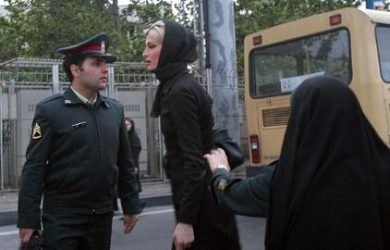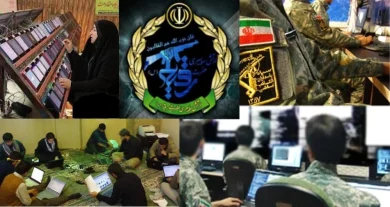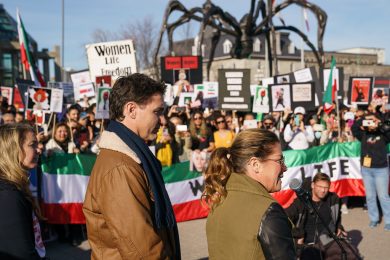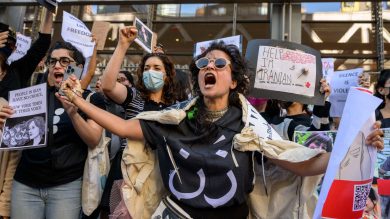The “Women, Life, Freedom” movement has shaken the foundations of the Iranian regime, proving that Iranian women are not only resisting oppression but also leading the fight for a democratic future. Despite the IRGC’s brutal crackdown, arrests, and censorship, this movement has evolved beyond the streets and protests. The question now is: What comes next?
Iran’s women-led resistance is at a critical juncture. With protests being met with violence and imprisonment, activists and organizers must look toward long-term strategies that ensure the movement’s sustainability and success. This article explores:
• How the resistance has evolved beyond street protests.
• Tactics and strategies Iranian women are using to sustain the fight.
• The role of exiled activists and the Iranian diaspora.
• How international solidarity and sanctions can support the movement.
• The future of Iran’s women-led resistance and its impact on democracy, human rights, and political reform.
1. From Protests to Sustained Resistance: The Evolution of the Movement
A. The Rise of a Women-Led Revolution
The death of Mahsa Amini in 2022 ignited a nationwide uprising, but Iran’s women-led resistance has roots far deeper:
• Women’s protests against compulsory hijab laws began decades ago.
• The 2009 Green Movement saw women front and center, challenging election fraud.
• 2017–2018 protests linked economic issues with gender oppression.
Unlike previous movements, today’s resistance is not just about reform—it demands structural change and an end to IRGC control.
B. How the Movement Has Shifted
With IRGC forces brutally suppressing street protests, the resistance has evolved into:
1. Grassroots organizing—women leading community-based activism in secret.
2. Labor and student movements—linking women’s rights to broader social justice struggles.
3. Digital resistance—spreading information through encrypted apps and satellite networks.
4. Economic boycotts—targeting IRGC-controlled businesses to weaken the regime.
5. Underground education—teaching feminism, human rights, and resistance strategies outside state control.
Women have adapted by taking the fight beyond the streets, ensuring the movement remains alive even under extreme repression.
2. Tactics and Strategies: How Women Are Sustaining the Fight
A. Digital Resistance and Online Organizing
Despite internet blackouts and IRGC cyber surveillance, women are using:
✔ VPNs and encrypted messaging apps to bypass censorship.
✔ Social media activism to amplify their voices globally.
✔ Hacktivism to expose regime corruption and disrupt propaganda networks.
Case Study: Masih Alinejad’s #MyStealthyFreedom
Exiled journalist Masih Alinejad runs online campaigns encouraging Iranian women to:
• Share photos without hijabs as acts of defiance.
• Expose IRGC abuses through social media.
• Mobilize international pressure on the regime.
These digital strategies ensure Iranian women’s voices are heard, even when the regime tries to silence them.
B. Economic Resistance: Boycotting the Regime’s Power
Women are leading economic boycotts to target the IRGC’s financial empire, which funds repression.
• Refusing to buy products from IRGC-linked businesses.
• Encouraging international sanctions on companies tied to the regime.
• Disrupting state-controlled industries through labor strikes.
By weakening the regime’s economy, Iranian women are challenging its financial backbone.
C. Underground Education and Community Organizing
With schools enforcing state propaganda, women are creating alternative education networks:
• Teaching banned subjects like feminism, democracy, and human rights.
• Hosting secret study circles where women learn about political activism.
• Empowering the next generation of leaders through underground training.
Education is a long-term tool for resistance, ensuring Iran’s future leaders are prepared for change.
3. The Role of Exiled Activists and the Iranian Diaspora
A.Iranian Women in Exile: Leading from Abroad
Many activists who fled Iran now play key roles in global advocacy:
• Masih Alinejad—campaigning for sanctions and global action against the IRGC.
• Narges Mohammadi—despite imprisonment, her writings expose Iran’s prison abuses.
• Shirin Ebadi—Nobel laureate, advocating for international legal action against the regime.
Their voices keep Iran in global headlines, ensuring continuous pressure on the regime.
B. How the Iranian Diaspora Can Help
Millions of Iranians abroad can:
✔ Lobby foreign governments for IRGC sanctions.
✔ Raise awareness through media and protests.
✔ Fund underground resistance efforts inside Iran.
Diaspora support is critical in keeping the movement alive.
4. The Importance of International Solidarity
A. Why Global Support Matters
Oppressive regimes rely on isolation. Global solidarity ensures that:
• Iran’s women are not forgotten.
• The regime is held accountable for its abuses.
• Governments and organizations take action.
International recognition of Iranian women’s struggle legitimizes their fight for freedom.
B. How the World Can Support Iranian Women
1. Sanctions Against the IRGC
✔ The U.S. has designated the IRGC as a terrorist organization—other countries must follow.
✔ Target IRGC-owned businesses to cut off funding for repression.
✔ Freeze assets of Iranian officials responsible for human rights violations.
2. Providing Safe Digital Access
✔ Tech companies should offer free VPNs and encrypted apps.
✔ Governments must support internet freedom initiatives in Iran.
3. Protecting Iranian Women Activists
✔ Grant asylum to persecuted activists.
✔ Offer legal aid to imprisoned journalists and protesters.
International action can empower Iranian women and weaken the regime’s grip on power.
5. The Future of Iran’s Women-Led Resistance
A. A Movement That Will Not Die
Unlike past uprisings, this movement has transformed Iranian society:
• Women’s resistance is now daily and widespread.
• The hijab is no longer a symbol of control—it has become a battleground.
• Younger generations are rejecting the regime entirely.
This movement is not just a protest—it is a revolution in progress.
B. What Comes Next?
1. More direct confrontations with the state.
2. Stronger underground networks to sustain activism.
3. Global recognition of Iran’s women-led revolution as a legitimate force for change.
Despite IRGC brutality, the movement cannot be erased. Women have set Iran on a path toward transformation—and there is no turning back.
Conclusion: Women Are the Future of a Free Iran
Iranian women have proven that they are unstoppable. From the streets to the digital space, from inside prisons to global advocacy, they are redefining resistance.
The fight is far from over, but the movement has already changed Iran forever. With continued resistance, global support, and strategic action, the future of Iran belongs to its women—and that future is one of freedom.
Join Our Newsletter!
Stay informed with the latest updates, news, and ways to take action in the fight for justice and global security. Sign up now to get updates delivered straight to your inbox!





